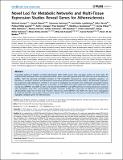| dc.contributor.author | Inouye, Michael | |
| dc.contributor.author | Ripatti, Samuli | |
| dc.contributor.author | Kettunen, Johannes | |
| dc.contributor.author | Lyytikäinen, Leo-Pekka | |
| dc.contributor.author | Oksala, Niku | |
| dc.contributor.author | Laurila, Pirkka-Pekka | |
| dc.contributor.author | Kangas, Antti J. | |
| dc.contributor.author | Soininen, Pasi | |
| dc.contributor.author | Savolainen, Markku J. | |
| dc.contributor.author | Viikari, Jorma | |
| dc.contributor.author | Kähönen, Mika | |
| dc.contributor.author | Perola, Markus | |
| dc.contributor.author | Salomaa, Veikko | |
| dc.contributor.author | Raitakari, Olli | |
| dc.contributor.author | Lehtimäki, Terho | |
| dc.contributor.author | Taskinen, Marja-Riitta | |
| dc.contributor.author | Järvelin, Marjo-Riitta | |
| dc.contributor.author | Ala-Korpela, Mika | |
| dc.contributor.author | Palotie, Aarno | |
| dc.contributor.author | de Bakker, Paul I Wen | |
| dc.date.accessioned | 2013-03-29T20:01:03Z | |
| dc.date.issued | 2012 | |
| dc.identifier.citation | Inouye, Michael, Samuli Ripatti, Johannes Kettunen, Leo-Pekka Lyytikäinen, Niku Oksala, Pirkka-Pekka Laurila, Antti J. Kangas, et al. 2012. Novel loci for metabolic networks and multi-tissue expression studies reveal genes for atherosclerosis. PLoS Genetics 8(8): e1002907. | en_US |
| dc.identifier.issn | 1553-7390 | en_US |
| dc.identifier.issn | 1553-7404 | en_US |
| dc.identifier.uri | http://nrs.harvard.edu/urn-3:HUL.InstRepos:10482575 | |
| dc.description.abstract | Association testing of multiple correlated phenotypes offers better power than univariate analysis of single traits. We analyzed 6,600 individuals from two population-based cohorts with both genome-wide SNP data and serum metabolomic profiles. From the observed correlation structure of 130 metabolites measured by nuclear magnetic resonance, we identified 11 metabolic networks and performed a multivariate genome-wide association analysis. We identified 34 genomic loci at genome-wide significance, of which 7 are novel. In comparison to univariate tests, multivariate association analysis identified nearly twice as many significant associations in total. Multi-tissue gene expression studies identified variants in our top loci, SERPINA1 and AQP9, as eQTLs and showed that SERPINA1 and AQP9 expression in human blood was associated with metabolites from their corresponding metabolic networks. Finally, liver expression of AQP9 was associated with atherosclerotic lesion area in mice, and in human arterial tissue both SERPINA1 and AQP9 were shown to be upregulated (6.3-fold and 4.6-fold, respectively) in atherosclerotic plaques. Our study illustrates the power of multi-phenotype GWAS and highlights candidate genes for atherosclerosis. | en_US |
| dc.language.iso | en_US | en_US |
| dc.publisher | Public Library of Science | en_US |
| dc.relation.isversionof | doi:10.1371/journal.pgen.1002907 | en_US |
| dc.relation.hasversion | http://www.ncbi.nlm.nih.gov/pmc/articles/PMC3420921/pdf/ | en_US |
| dash.license | LAA | |
| dc.subject | Biology | en_US |
| dc.subject | Genetics | en_US |
| dc.subject | Gene Expression | en_US |
| dc.subject | Genome-Wide Association Studies | en_US |
| dc.subject | Systems Biology | en_US |
| dc.subject | Medicine | en_US |
| dc.subject | Cardiovascular | en_US |
| dc.subject | Atherosclerosis | en_US |
| dc.title | Novel Loci for Metabolic Networks and Multi-Tissue Expression Studies Reveal Genes for Atherosclerosis | en_US |
| dc.type | Journal Article | en_US |
| dc.description.version | Version of Record | en_US |
| dc.relation.journal | PLoS Genetics | en_US |
| dash.depositing.author | de Bakker, Paul I Wen | |
| dc.date.available | 2013-03-29T20:01:03Z | |
| dc.identifier.doi | 10.1371/journal.pgen.1002907 | * |
| dash.authorsordered | false | |
| dash.contributor.affiliated | de Bakker, Paul | |


